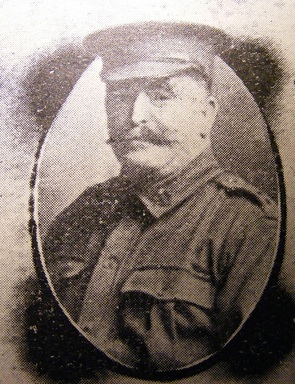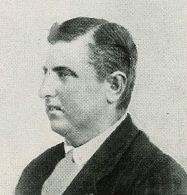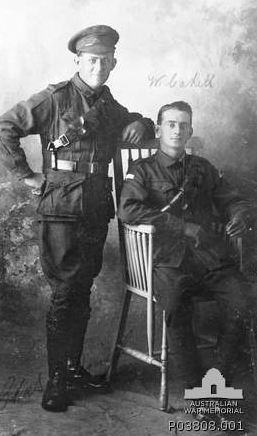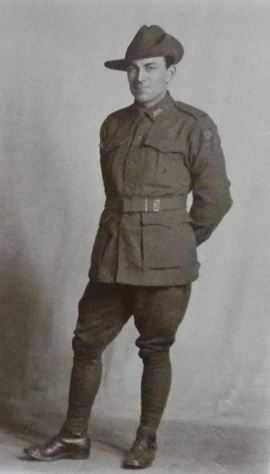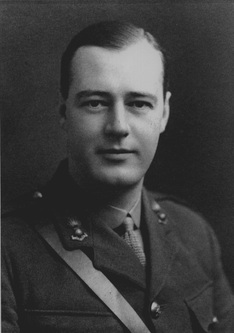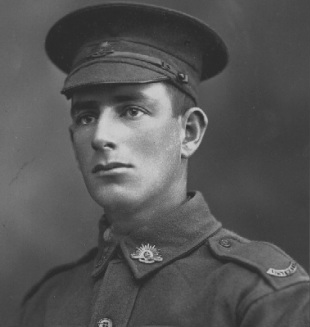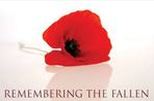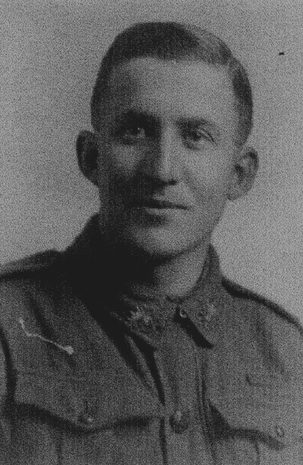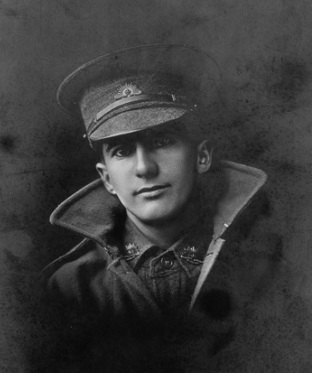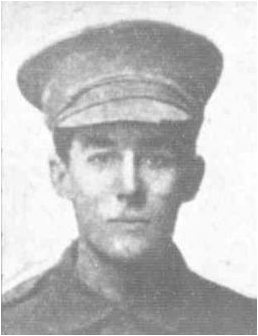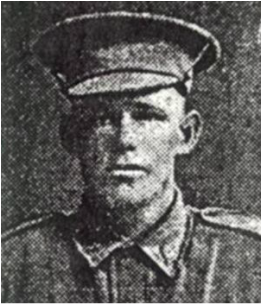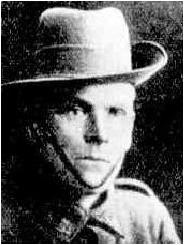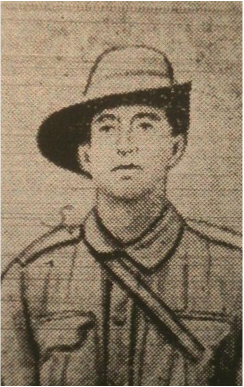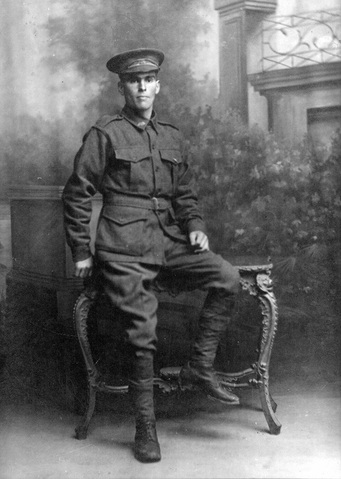"A noble hero true and brave, peacefully sleeps in a soldier's grave"
DANIELS, Charles Ernest (standing)
Service no 1898
Private 50th Battalion Born 28 November 1891 at Thebarton, SA Son of Walter DANIELS & Sarah nee SYKES Husband of Rhoda Tolbois DANIELS Of Miller Road, Glanville, SA Occupation prior to enlistment Labourer Enlisted 13 March 1916 at Adelaide, SA Served in France Returned to Australia 06 June 1919 per 'Commonwealth' www.awm.gov.au P03808.001 |
DANKEL, Georg Emil
Service no 7492
Private 4th Divisional Train Born 29 June 1888 at Norwood, SA Son of Georg Caspar Adolph Maria Prospers DANKEL & Emilie nee HESE Of Regent St., Kensington, SA Occupation prior to enlistment Butcher Enlisted 09 June 1915 at Keswick, SA Served in France Returned to Australia 23 October 1919 per 'Plassy' www.awm.gov.au DA11485 |
Attended Pulteney Street School 1906-1911
The third of four sons of WH and Annie Davenport, of the Arab Steed Hotel, Leslie attended Pulteney for six years, steadily moving through all grades. A good sportsman he won the 120 yards flat race (U13) at the 1907 Annual Sports Day. He was also a keen footballer, playing for the South Adelaide Juniors.
Leslie enlisted in March 1916, arriving in France in June. He joined his unit in August and was killed in action on February 16, 1917.
Private Leslie Davenport is remembered at Villers-Bretonneux Memorial, France.
Courtesy of Pulteney Grammar School
The third of four sons of WH and Annie Davenport, of the Arab Steed Hotel, Leslie attended Pulteney for six years, steadily moving through all grades. A good sportsman he won the 120 yards flat race (U13) at the 1907 Annual Sports Day. He was also a keen footballer, playing for the South Adelaide Juniors.
Leslie enlisted in March 1916, arriving in France in June. He joined his unit in August and was killed in action on February 16, 1917.
Private Leslie Davenport is remembered at Villers-Bretonneux Memorial, France.
Courtesy of Pulteney Grammar School
DAVEY, Reginald Argyle
Lieutenant
Royal Navy Volunteer Service HMS Campania Born: 19 October 1896 in Adelaide, SA Son of Arnold Edwin & Sarah DAVEY nee SHANNON Of St Peters, SA Accidental death: 8 September 1916 Drowned in Accident to Kite Balloon Buried: Chatham Naval Memorial Cemetery, U.K. Courtesy of Douglas Paterson Researching Prince Alfred College WWI Soldiers State Records of SA GRG 26/5/4/1100 |
DAVIDSON, James Lundie
Service No. 35225
Gunner 3rd Field Artillery Brigade Born Hawick, Scotland Husband of Pearl DAVIDSON Of 1 Victoria Ave., Rose Park, SA Occupation prior to enlistment Clerk Enlisted on 31 October 1916 at Adelaide, SA Embarked from Melbourne on 9 November 1917 aboard per 'Port Sydney' Served in France Returned to Australia 06 August 1919 per 'Konig Frederich August' He died on 14 October 1956 www.awm.gov.au P07159.118 |
Harold Whitridge Davies (1894-1946), professor of physiology, was born on 27 June 1894 in Adelaide, eldest of five children of Edward Harold Davies, musician and music teacher, and his wife Ina Jane, née Deland. Educated at Prince Alfred College, Harold graduated from the University of Adelaide (M.B., B.S., 1917) and on 5 July 1917 was appointed captain, Australian Army Medical Corps, Australian Imperial Force. He served on the Western Front with the 3rd Division. From late 1919 Davies spent three terms as an advanced student at New College, Oxford. He then worked at the Ashurst War Hospital as a research-assistant to J. S. Haldane, a leading respiratory physiologist. Davies's first scientific papers were in this field, which was to be his major research interest throughout the rest of his career.
After his A.I.F. appointment terminated in Adelaide on 12 August 1920, Davies followed Professor J. C. Meakins, with whom he had worked at Oxford, to the University of Edinburgh. As a research-assistant and lecturer, Davies continued to publish papers mainly concerned with the influence of circulatory disturbances on the gaseous exchange of the blood. His monograph with Meakins, Respiratory Function in Disease (London), appeared in 1925. He also published with C. G. Lambie and others on the use of insulin in diabetic patients. Having been appointed a Rockefeller Foundation fellow (for one year) in 1923, Davies worked with C. A. L. Binger at the Hospital of the Rockefeller Institute of Medical Research in New York and was associated with some of the leading respiratory physiologists in the United States of America. In 1926 he moved from Edinburgh to the University of Leeds, England, as lecturer in physiology and pharmacology.
In 1930 Davies was appointed professor of physiology at the University of Sydney. On his arrival he found that the academic staff of the department had remained largely unchanged since World War I. The small amount of research that was being done was generally reported only in Australian journals. Davies arranged for two staff members—H. S. Wardlaw in 1930 and F. S. Cotton in 1933—to be awarded Rockefeller fellowships to work in the U.S.A.
In 1933 and 1934 Davies made two expeditions to Central Australia to study the possibility that Aborigines living in the hot, arid conditions there could have become especially adapted to water deprivation. The first expedition, with Wardlaw and three students, was to Hermannsburg, 70 miles (113 km) south-west of Alice Springs, Northern Territory. The second, which included T. G. Strehlow, was to Mount Liebig, 155 miles (249 km) north-west of Alice Springs. They concluded that there was no significant difference between the Black and the White man's adaptation to water deprivation.
Faced with formidable difficulties in building up the department of physiology, Davies proved unable to sustain his initial impact. When he had come to Sydney the Depression was at its worst and there was little possibility of making new staff appointments. In addition, the department was responsible for teaching both biochemistry and physiology, and from 1935 classes in pharmacology became an added burden. In the face of these difficulties, he began drinking heavily.
Unmarried, 'Pete' Davies was a kind and generous man who was held in affectionate regard by his many friends. He was a competent cellist and a bon viveur. An honorary consultant physiologist at three teaching hospitals, he became a foundation fellow of the Royal Australasian College of Physicians in 1938. That year a complaint from the medical students' society about the teaching of physiology and pharmacology was upheld by an investigatory sub-committee of the university's senate. In consequence, pharmacology was removed from the department of physiology and a separate department of biochemistry was established.
The outbreak of World War II provided Davies with a diversion from the cares of his department. An army reservist from 1920, he was mobilized as lieutenant colonel in June 1941 and commanded the 9th Field Ambulance for seven months; he was bitterly disappointed not to be sent overseas and relinquished his post in January 1942. Reports of his excessive drinking obliged the vice-chancellor to suspend him from duty at the university in May 1946. A committee of senate appointed to inquire into the suspension decided on 24 May to recommend that Davies be informed that the university no longer required his services. He died of a cerebral haemorrhage on 7 June that year, as a result of falling down the stairs in the Imperial Service Club, Barrack Street, Sydney, and was cremated with Anglican rites.
by P.O. Bishop
Australian Dictionary of Biography Volume 13 (MUP) 1993
After his A.I.F. appointment terminated in Adelaide on 12 August 1920, Davies followed Professor J. C. Meakins, with whom he had worked at Oxford, to the University of Edinburgh. As a research-assistant and lecturer, Davies continued to publish papers mainly concerned with the influence of circulatory disturbances on the gaseous exchange of the blood. His monograph with Meakins, Respiratory Function in Disease (London), appeared in 1925. He also published with C. G. Lambie and others on the use of insulin in diabetic patients. Having been appointed a Rockefeller Foundation fellow (for one year) in 1923, Davies worked with C. A. L. Binger at the Hospital of the Rockefeller Institute of Medical Research in New York and was associated with some of the leading respiratory physiologists in the United States of America. In 1926 he moved from Edinburgh to the University of Leeds, England, as lecturer in physiology and pharmacology.
In 1930 Davies was appointed professor of physiology at the University of Sydney. On his arrival he found that the academic staff of the department had remained largely unchanged since World War I. The small amount of research that was being done was generally reported only in Australian journals. Davies arranged for two staff members—H. S. Wardlaw in 1930 and F. S. Cotton in 1933—to be awarded Rockefeller fellowships to work in the U.S.A.
In 1933 and 1934 Davies made two expeditions to Central Australia to study the possibility that Aborigines living in the hot, arid conditions there could have become especially adapted to water deprivation. The first expedition, with Wardlaw and three students, was to Hermannsburg, 70 miles (113 km) south-west of Alice Springs, Northern Territory. The second, which included T. G. Strehlow, was to Mount Liebig, 155 miles (249 km) north-west of Alice Springs. They concluded that there was no significant difference between the Black and the White man's adaptation to water deprivation.
Faced with formidable difficulties in building up the department of physiology, Davies proved unable to sustain his initial impact. When he had come to Sydney the Depression was at its worst and there was little possibility of making new staff appointments. In addition, the department was responsible for teaching both biochemistry and physiology, and from 1935 classes in pharmacology became an added burden. In the face of these difficulties, he began drinking heavily.
Unmarried, 'Pete' Davies was a kind and generous man who was held in affectionate regard by his many friends. He was a competent cellist and a bon viveur. An honorary consultant physiologist at three teaching hospitals, he became a foundation fellow of the Royal Australasian College of Physicians in 1938. That year a complaint from the medical students' society about the teaching of physiology and pharmacology was upheld by an investigatory sub-committee of the university's senate. In consequence, pharmacology was removed from the department of physiology and a separate department of biochemistry was established.
The outbreak of World War II provided Davies with a diversion from the cares of his department. An army reservist from 1920, he was mobilized as lieutenant colonel in June 1941 and commanded the 9th Field Ambulance for seven months; he was bitterly disappointed not to be sent overseas and relinquished his post in January 1942. Reports of his excessive drinking obliged the vice-chancellor to suspend him from duty at the university in May 1946. A committee of senate appointed to inquire into the suspension decided on 24 May to recommend that Davies be informed that the university no longer required his services. He died of a cerebral haemorrhage on 7 June that year, as a result of falling down the stairs in the Imperial Service Club, Barrack Street, Sydney, and was cremated with Anglican rites.
by P.O. Bishop
Australian Dictionary of Biography Volume 13 (MUP) 1993
DAVIS, Ernest Walter
DAVIS, Frank Watts
Service No 1524
Second Lieutenant 10th Battalion Born 9 Nov 1895 Wilcannia, N.S.W. Son of Frank Watts DAVIS & Martha nee STONE Frank, a fisherman of Port Lincoln, S.A. Enlisted 3 Dec 1914 Embarked from Melbourne aboard HMAT Runic on 19 February 1915. 19 Feb 1916 promoted Lance Corporal. March 1916 to 50 Battalion, promoted Corporal Apr 1916. Sergeant in Jun 1916. 26 August 1916 promoted to Second Lieutenant. 2 February 1917 he was killed in action in France aged 23 years. Buried Bernafay Wood British Cemetery, Montauban, France www.awm.gov.au P05279.001 |
DAVIS, Gilbert Walter
Service No. 5351
Private 10th Battalion Born on July 27, 1891 at Riverton, South Australia Son of Ruth (nee Burridge) and Henry Archibald Davis Of “Glen Ferrie”, Riverton, South Australia Occupation prior to enlistment Farm labourer Enlisted on January 22, 1916 at Adelaide, South Australia Served in Colombo, Egypt, France and Belgium He was awarded the Military medal for “devotion to duty and personal courage in carrying out rescue work east of Ypres – 19-22 September, 1917.” He was killed in action on October 8, 1917 at Anzac Ridge, Belgium aged 26 and is commemorated at The Ypres (Menin Gate) Memorial, Belgium www.awm.gov.au P09072.001 |
THE LATE PRIVATE J. DAVIS.
Private Jack Davis, of the 16th Battalion, 2nd Expeditionary Force, enlisted on September 15, 1914. In June he was wounded in six places with shrapnel, and had only been back in the firing line a few weeks when news came through that he was killed on August 8. He was born in Yongala, and spent his 27th birthday in the trenches. In July, 1914, previous to enlisting, he worked on the West Coast at Cowell, Tumby Bay, and Port Lincoln, and also for some time in the Broken Hill Proprietary Company's works, Port Pirie. He was the son of Mr. and Mrs. J. W. Davis, of Port Pirie, and was much respected.
The Chronicle Saturday 09 October 1915 page 42
Private Jack Davis, of the 16th Battalion, 2nd Expeditionary Force, enlisted on September 15, 1914. In June he was wounded in six places with shrapnel, and had only been back in the firing line a few weeks when news came through that he was killed on August 8. He was born in Yongala, and spent his 27th birthday in the trenches. In July, 1914, previous to enlisting, he worked on the West Coast at Cowell, Tumby Bay, and Port Lincoln, and also for some time in the Broken Hill Proprietary Company's works, Port Pirie. He was the son of Mr. and Mrs. J. W. Davis, of Port Pirie, and was much respected.
The Chronicle Saturday 09 October 1915 page 42
DAVY, Walter Allen (centre)
Service no 6231
Driver 10th Battalion Born 25 July 1888 at Morchard, SA Son of Robert DAVY and Agnes Frances nee LOFTUS Of Morchard, SA Occupation prior to enlistment Farm Labourer Enlisted 25 May 1916 at Orroroo, SA Served in England and France Returned to Australia 29 June 1919 per 'Nestor' www.awm.gov.au P04025.009 |
DAWE, Walter Stanley
Service no 2016
Corporal 32nd Battalion Born 04 May 1889 Kadina, South Australia Son of Richard DAWE & Elizabeth Ann nee HARRIS Next of kin Albert DAWE (brother) Of King William St., Adelaide, SA Occupation prior to enlistment Minister of Religion Enlisted 24 August 1915 at Adelaide, SA Served in Egypt, France and Belgium Killed in action 20th February 1918 in Belgium Aged 28 years Buried Messines Ridge British Cemetery www.awm.gov.au P03567.001 |
DAY, Angus Laurence
Service no 4695
Private 32nd Battalion Born 28 October 1891 near Kenton Valley, SA Son of John DAY & Auguste nee LEHMANN Of Inglewood, SA Occupation prior to enlistment Labourer Enlisted 26 January 1916 at Served in France Killed in Action 21 June 1918 in France Aged 26 years Buried Dive Copse British Cemetery www.awm.gov.au P07165.001 Courtesy of Helen Fay Smith |









































